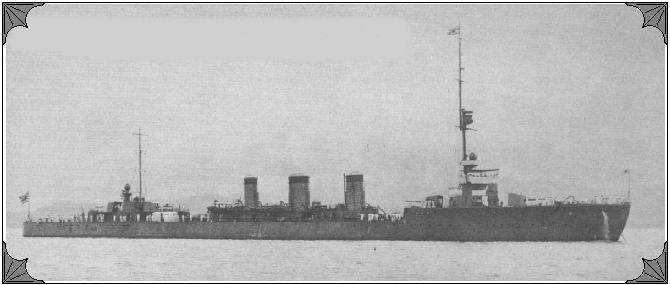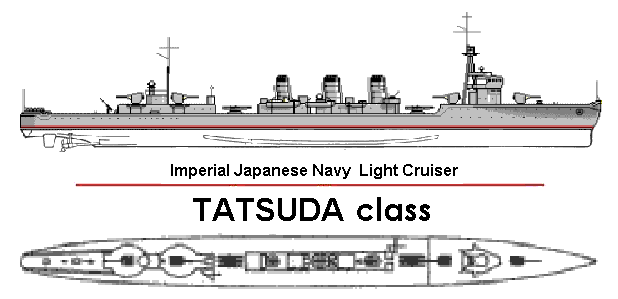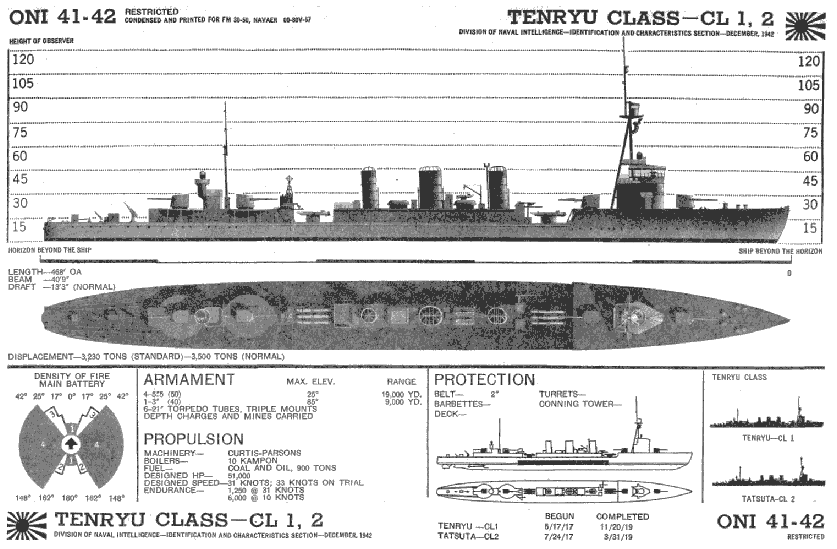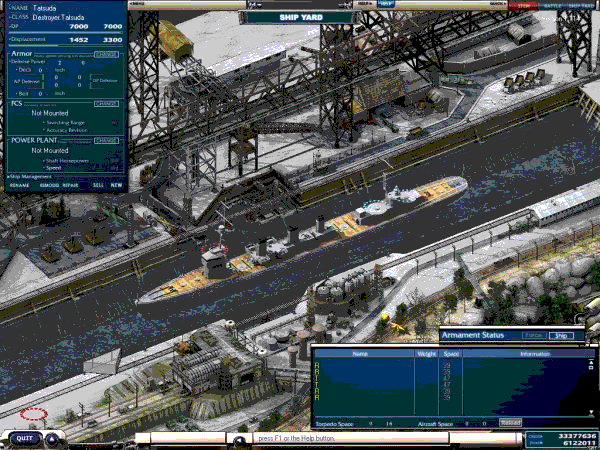
Imperial Japanese Navy - TATSUDA class Light Cruiser ==========================================================================

Tatsuta (Tatsuda) was the second ship in the two ship TenryŻ-class of light cruisers in the Imperial Japanese Navy. It was named after the Tatsuta River in Nara Prefecture, Japan.
The TenryŻ class light cruisers were essentially enlarged destroyers, inspired by and designed with a similar concept to the Royal Navy Arethusa class and C-class cruisers. These were the first ships in the Japanese navy to be armed with triple torpedo tubes. These ships were designed to act as flagships for destroyer flotillas.
With improvements in oil-fired turbine engine technology, the TenryŻ-class had more than twice the horsepower of the previous Chikuma-class, and were capable of the high speed of 33 knots (61 km/h).
Tatsuta was completed at the Sasebo Naval Arsenal on 31 March 1919. Prior to World War II, it participated in the Siberian Intervention, and supported the landings of Japanese troops along the China coast. During the Pacific War, it participated in the Battle of Wake Island and the invasions of the Solomon Islands, New Guinea and the Battle of Savo Island and the Naval Battle of Guadalcanal. It was sunk by USS Sand Lance, 40 nautical miles (74 km) NNE of HachijŰjima on 13 March 1944.
The two TenryŻ class cruisers were first light cruisers operated by the Imperial Japanese Navy. They participated in numerous actions during World War II.
The TenryŻ-class was followed by the larger and more versatile Kuma class.
Authorized during World War I, the TenryŻ class was the first series of light cruisers to be designed by the Japanese, albeit based on current Royal Navy models.
Speed was an emphasis in their design and their turbine engines were the next step up from previous models. With oil-fired single-reduction Brown-Curtis geared turbine engines providing more than twice the power of the engines in the previous Chikuma-class, the TenryŻ-class cruisers were capable of the relatively high speed of 33 knots (61 km/h).
In terms of armament, these ships were the first in the Imperial Japanese Navy to be with the then brand new 5.5in guns, which replaced a heavier 6in guns and were also the first armed with triple 550 mm torpedoes. However, the gun layout was not particularly effective due to restricted arcs of movement. Against targets ahead and astern of the ship, only one 140 mm gun could be fired. The firing arcs of the No. 2 and No. 3 turrets were very limited. Anti-aircraft fire was initially also very limited, consisting of one 3.1-inch (79 mm) gun and two 13 mm machine guns.
Although modernized in the early 1930s, they were still considered obsolete at the start of the Pacific War.
The cruiser generally operated in Chinese waters for the rest of the decade, with brief intervals of duty as a training ship and in reserve. Plans to convert her to an anti-aircraft ship were cancelled in 1939, and she spent the next two years as a training ship at Maizuru Naval Station and on a cruise through the central Pacific in mid-1941.
When the war with the United States began in December 1941, Tenryu was first employed in the operation to capture Wake Island. In January-April 1942, she participated in the capture of New Ireland, New Britain, northeastern New Guinea, Bougainville and the Admiralty Islands. During the early May Battle of the Coral Sea, Tenryu supported the abortive operation to seize Port Moresby. In July and August 1942, following an overhaul in Japan, she served as an escort for transports in the New Britain and New Guinea areas, and also took part in the Battle of Savo Island on 9 August.
Over the next four months, she was actively engaged in the unsuccessful campaigns to capture Milne Bay, in eastern New Guinea, and retake Guadalcanal. She was damaged by a bomb on 2 October, made two transport runs to Guadalcanal in early November and covered the 14 November bombardment of Henderson Field. While participating in operations off Madang, New Guinea, on 18 December 1942, Tenryu was torpedoed and sunk by the U.S. submarine Albacore (SS-218). Approximately two years later, her sister the Tatsuta was sunk by the American submarine Sand Lance.
=================================================================================
NB: The above text has been collected / excerpted / edited / mangled / tangled / re-compiled / etc ... from the following online sources :
IJN - TATSUDA class Light Cruiser - wikipedia article #1
IJN - TATSUDA class Light Cruiser - wikipedia article #2
IJN - TATSUDA class Light Cruiser - www.globalsecurity.org



